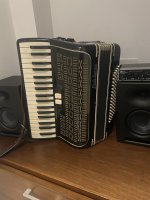On a Stradella accordion, there is also the inherent function that the “piano side” is the star of the show and so if playing with a single Reed, it would be overpowered by a loud bass, that is way more a negative. Your thought process is as of a piano tuner, you cannot apply those traits to an accordion… because it is not a piano.
First thing to check out is how the accordion sounds when someone else is listening. The balance between the treble and bass side can only be truly heard by the audience, not by the player. Accordions are (supposed to be) designed so that the sound that comes out from the treble side (which is closest to your head) is diverted away from the player and towards the audience as much as possible, to prevent the player from going deaf (from excessive sound volume). As a result the player does not hear the balance very well.
However, the notes should still respond the same way when the bellows are used with the same amount of force (thus forcing the same amount of air through the treble notes, while forcing much more air through the much larger bass reeds). If you are simply aiming for the same amount of total sound volume then the treble is actually played more softly, hence the problem with note response.
That said... there are large differences in the balance between treble and bass between brands and models, as well as large differences in the total amount of sound produced for roughly the same amount of force.
Ok, thanks for the response. I had a feeling what you suggested regarding balance maybe have been the case and if I’m understanding correctly the response issue may be more due to my playing skills (or lack of) than the accordion itself.

